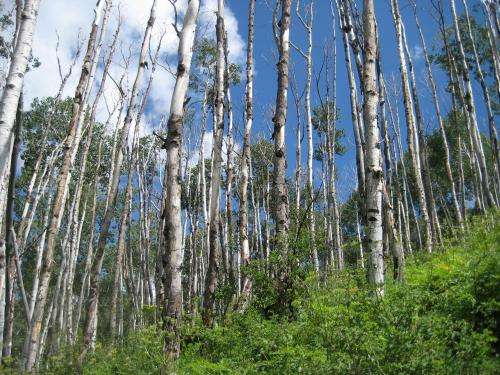Drought damage leads to widespread forest death

The 2000-2003 drought in the American southwest triggered a widespread die-off of forests around the region. A Carnegie-led team of scientists developed a new modeling tool to explain how and where trembling aspen forests died as a result of this drought. It is based on damage to the individual trees' ability to transport water under water-stressed conditions.
If the same processes and threshold govern the future, their results suggest that more widespread die-offs of aspen forests triggered by climate change are likely by the 2050s. Tree mortality can radically transform ecosystems, affect biodiversity, harm local economies, and pose fire risks, as well as further increase global warming.
Their work aimed to address a longstanding disagreement over how climate change caused by the emission of greenhouse gasses will affect forest ecosystems. On one hand, rising concentrations of carbon dioxide can benefit trees and help them use water more efficiently. On the other hand, rising temperatures and resulting droughts from climate change can cause many forest trees to die off. Most current models of forests under climate change cannot predict when or where forests might die from temperature and drought stress. The model created by the team including Carnegie's William Anderegg (now at Princeton University), Joseph Berry, and Christopher Field fills this gap by accurately simulating the widespread aspen mortality caused by the 2000-2003 drought. Their findings are published by Nature Geoscience.
Forests are central to many of the planet's chemistry and energy cycles. They also play an important role in human life on the planet both aesthetically and by providing lumber, as well as fruits and nuts for food.
"A forest die-off over a large area like the Amazon Basin, could have a major impact on Earth's system as a whole," said Berry.
The drought-triggered aspen die-off has affected about 17 percent of aspen forests in Colorado, as well as parts of the western United States and Canada. In order to make an accurate model, the team focused on the physiology of how drought kills trees, a subject they have studied extensively in recent years.
They found that drought causes damage to the vascular system that transports water throughout the tree. The threshold for a lethal amount of vascular damage was not previously known in any tree species. But using data from forests in southwest Colorado, they were able to identify a threshold over which drought conditions start to degrade an aspen's water-transporting vascular system. They incorporated this information into a model designed to predict drought-induced forest mortality. They tested the model against regional forest mortality observations from scientific forest plots, aerial surveys done by the U.S. Forest Service, and satellite measurements.
When this model was then applied to the future, they found that in a world of continuing high greenhouse gas emissions, the threshold for widespread drought-induced vascular damage would be crossed and initiate widespread tree deaths on average across climate model projections in the 2050s. Crucially, lower greenhouse gas emissions scenarios did not always lead to widespread tree mortality.
The team also included Alan Flint and Lorraine Flint of the United States Geological Survey, Cho-ying Huang of National Taiwan University, Frank Davis of the University of California Santa Barbara, and John Sperry of University of Utah.
"Finding the thresholds in plant physiology after which climate stress causes tree mortality will allow us to resolve uncertainty over the fate of forest ecosystems in a changing climate," said lead author Anderegg. "But most importantly, a lot rides on human decisions to slow climate change. The clock is ticking on the future of these forests."
More information: Nature Geoscience, DOI: 10.1038/ngeo2400
Journal information: Nature Geoscience
Provided by Carnegie Institution for Science

















